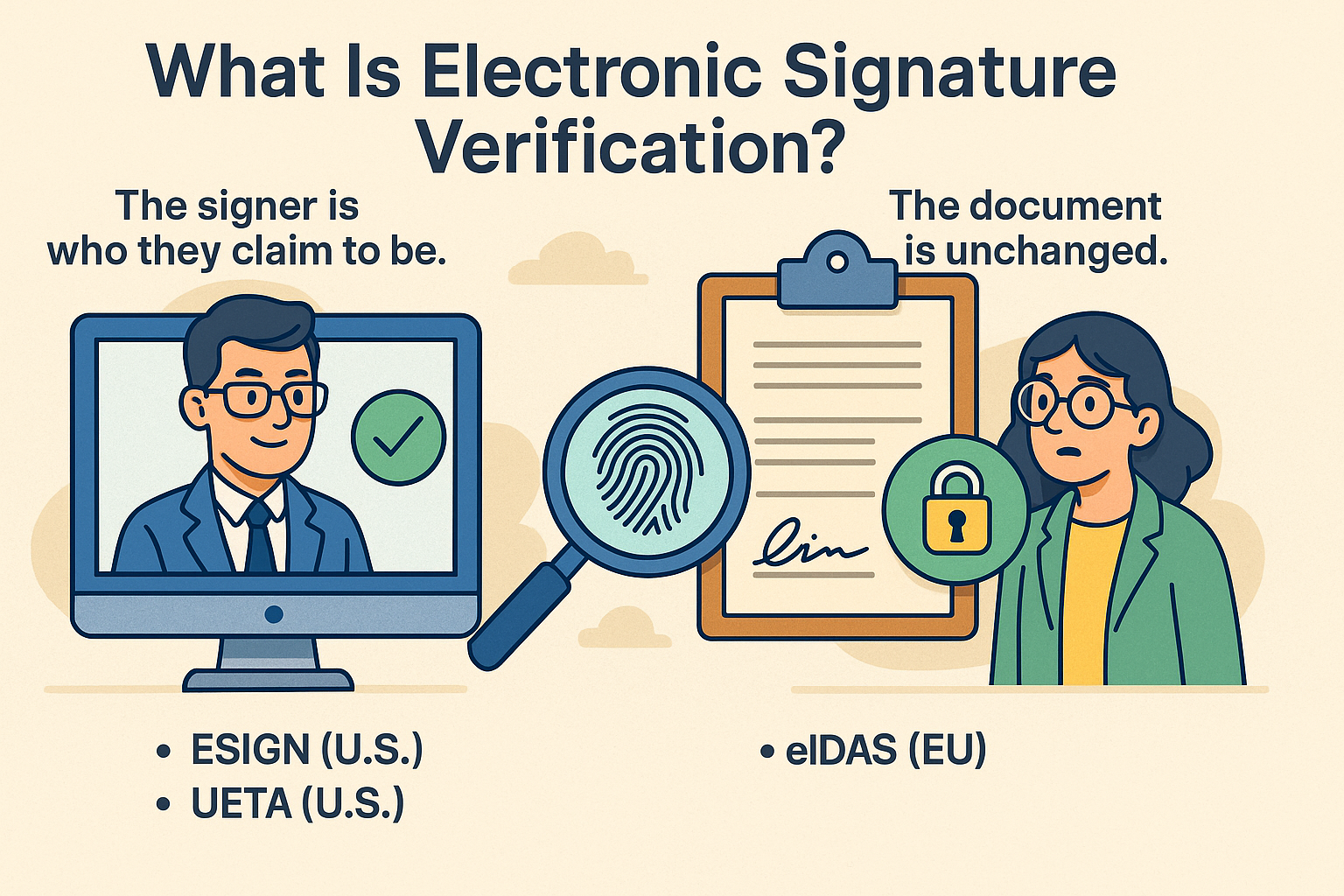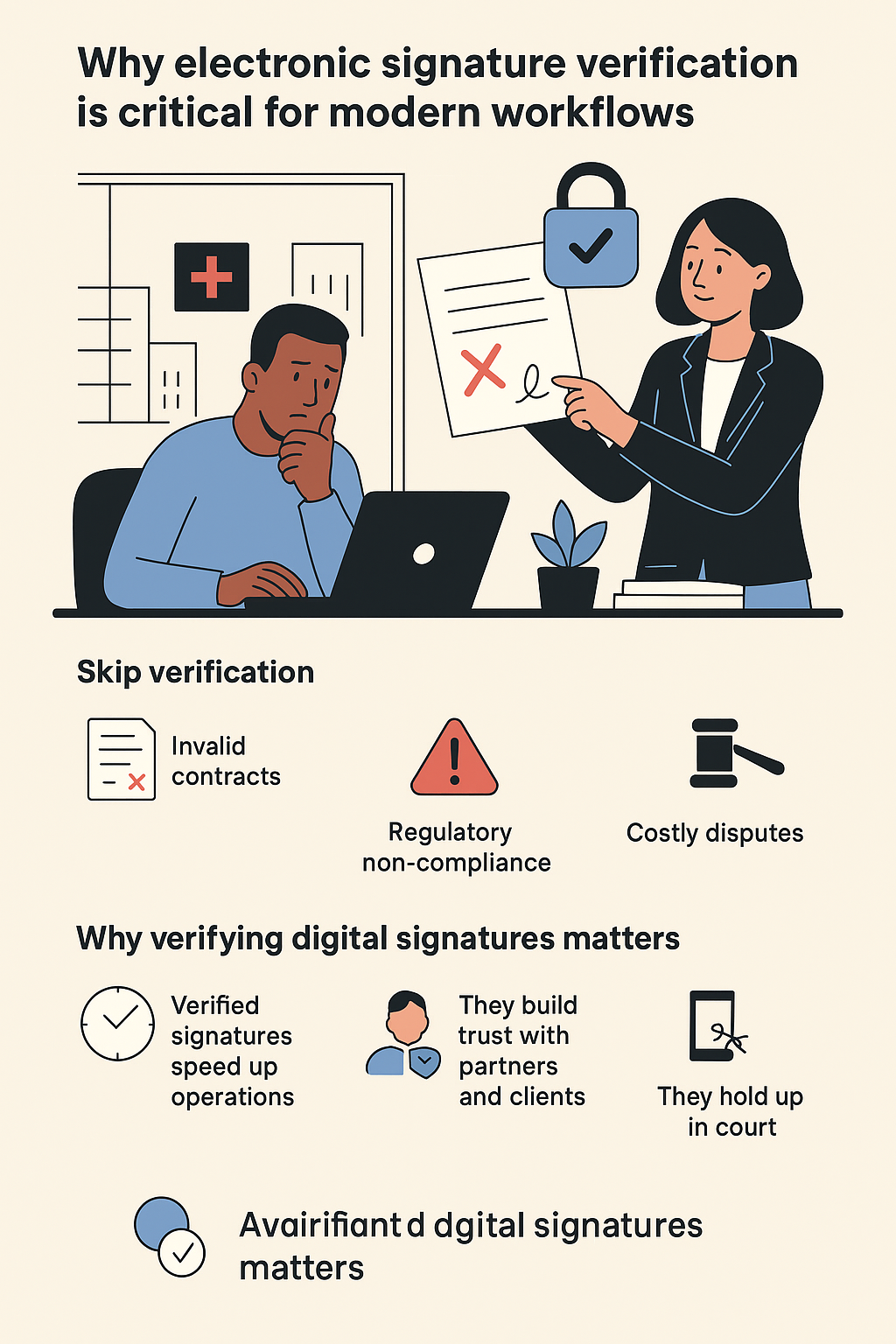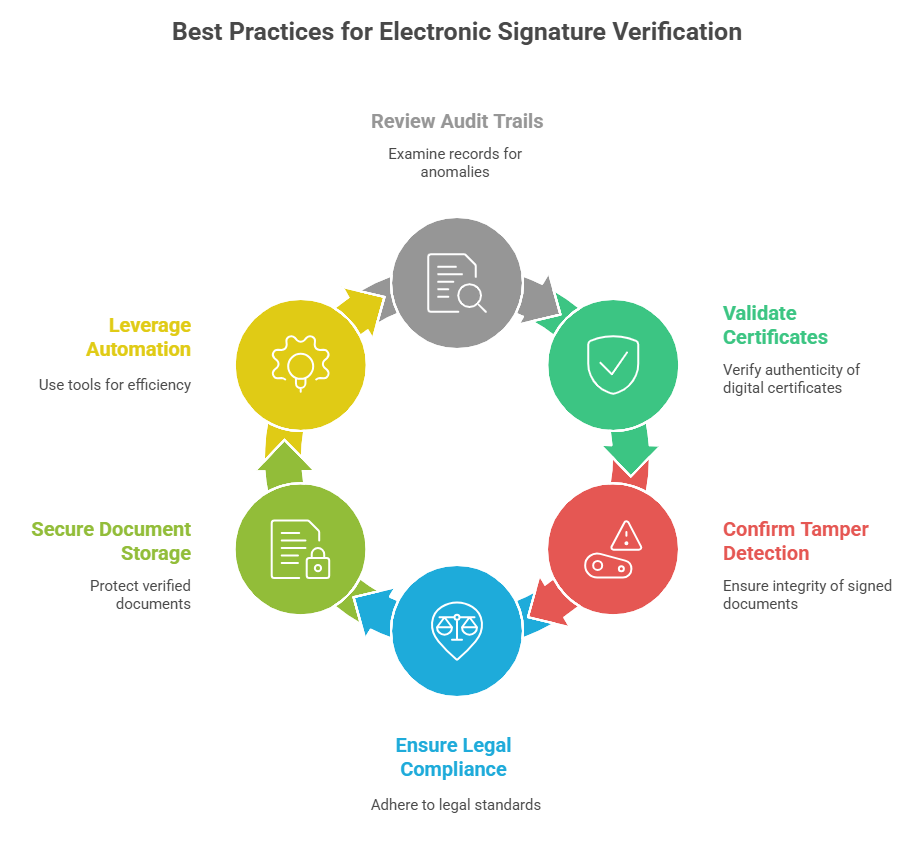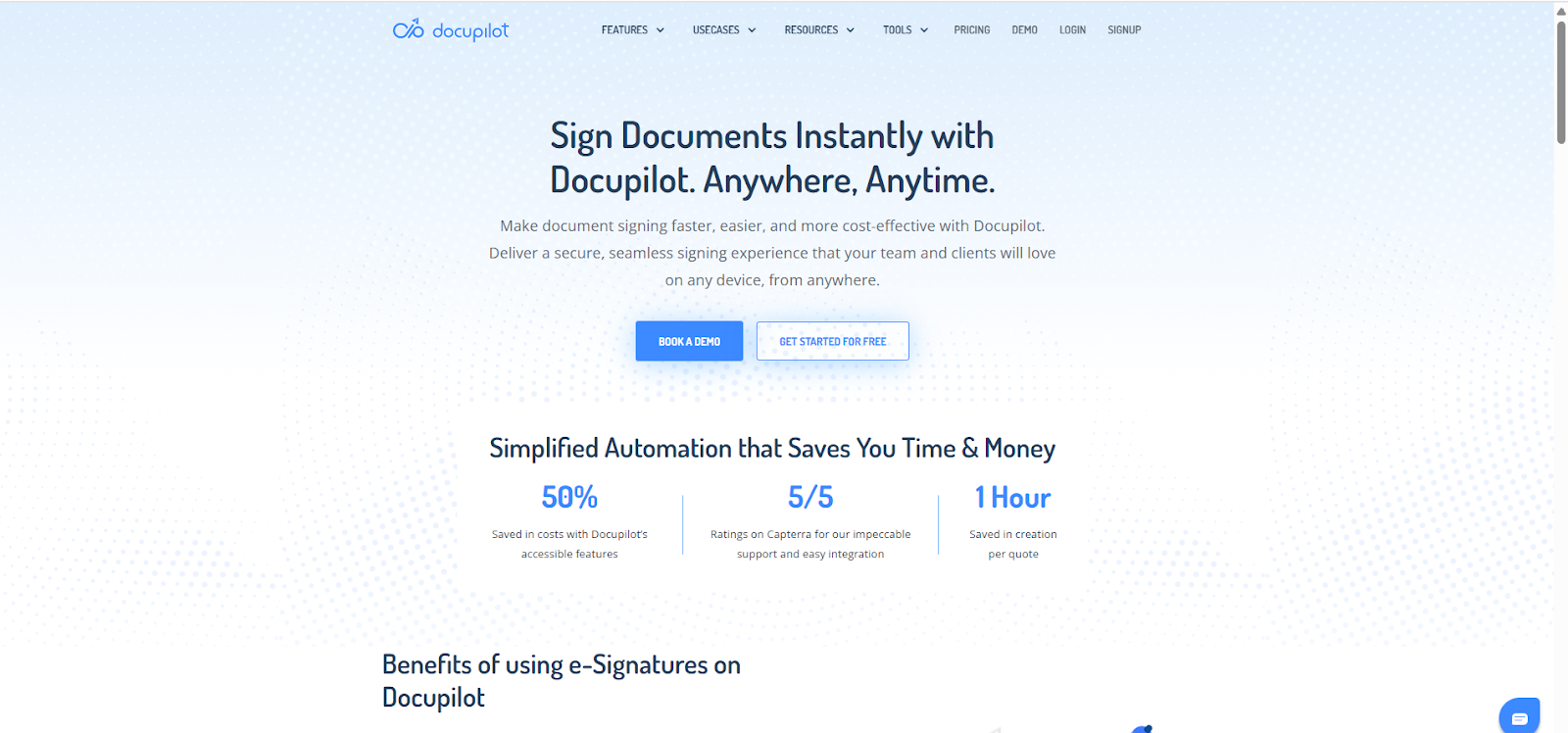Key takeaways
- Verification isn’t optional: Without it, e-signatures can be challenged, fail audits, or lose legal standing
- It’s more than a visual check: True verification uses identity proofing, digital certificates, and tamper detection
- Automation builds trust: Platforms like Docupilot validate every document instantly for speed, accuracy, and compliance
A signed PDF doesn’t guarantee security. It may look legitimate, but signatures can be forged, documents altered, and the damage often surfaces during a dispute or audit.
Nearly 80% of risk leaders report a year-over-year increase in fraud attempts. Without proper verification, businesses face legal disputes, compliance failures, and reputational damage, often alongside financial loss.
This post explains what electronic signature verification is, why it’s essential, and how to ensure every signed document you send or receive stands up to legal and compliance scrutiny.
What is electronic signature verification?

Electronic signature identity verification is about proving two things beyond a shadow of a doubt:
- The signer’s identity: Confirming they are exactly who they claim to be.
- The document’s integrity: Ensuring nothing has been altered since signing.
This is more than just a casual glance to see if the right name is typed in the signature field. Real verification relies on encryption, digital certificates, and detailed audit logs to create evidence that can stand up in court. Think of it as giving your document a digital fingerprint, unique and impossible to fake without detection.
The process is guided by legal frameworks that define what counts as a valid, enforceable electronic signature:
- ESIGN (U.S.): Establishes that e-signatures are as legally binding as ink-on-paper when certain conditions are met
- UETA (U.S.): Ensures that all U.S. states treat e-signatures consistently under the law
- eIDAS (EU): Defines strict requirements for identity verification and tamper-proof document handling across Europe
Why electronic signature verification is critical for compliance and risk management

Business today moves at the speed of email. Entire contracts are signed without a single face-to-face meeting. That convenience comes with a risk: without verification, trust rests on assumptions instead of proof.
Failing to verify opens the door to:
- Invalid contracts: Opposing counsel can dispute authenticity
- Regulatory non-compliance: Audits fail when verifiable records are missing
- Costly disputes: Legal challenges can drag on for months, often ending in lost cases
The stakes continue to rise. Digital document forgeries surged 244% last year, and deepfakes now account for 40% of biometric fraud incidents. Old-fashioned forgery once took skill; now, all it takes is a PDF editor and bad intentions.
Verification is your legal armor, ensuring contracts hold up in court and that every signing event is recorded in a way that meets global e-signature laws.
Benefits of verifying digital signatures
While compliance and legal protection are vital, verification also drives measurable business results.
- Close deals faster: Skip manual checks and sign off in minutes
- Earn client trust: Show you protect every agreement
- Smooth experience: Quick, secure signing keeps deals moving
- Work smarter: Automation frees your team from repetitive checks
- Stand out: Security and compliance can tip the deal in your favor
How electronic signature verification works
Verifying an electronic signature is a multi-step process that ensures the document is both authentic and untampered with. Here’s how it happens:
- Identity check: Confirms the signer through email verification, government ID, or multi-factor authentication. The higher the stakes, the stricter the check
- Digital certificate creation: Creates a cryptographic “fingerprint” of the document. Any change, even a comma, breaks the match
- Audit trail logging: Logs who signed, when, and from where, creating a tamper-proof timeline
- Integrity seal: Locks the document. Any edit after signing flags it as invalid
Think of it like sending a sealed, GPS-tracked package—you’ll know immediately if anyone tampers with it.
Common use cases for signature verification
1. Legal documents
- Contracts and agreements: NDAs, employment agreements, and business contracts need verified signatures to be binding
- Identity check: Email or multi-factor authentication confirms the right person signed
- Tamper protection: Access logs and encryption ensure documents stay unchanged
- Compliance: Meets ESIGN Act, eIDAS, and other legal requirements
2. Financial transactions
- Fraud prevention: Confirms the signer’s identity for loans, investments, and insurance
- Data security: Encryption keeps financial documents safe from edits
- Regulatory compliance: Aligns with Dodd-Frank, MiFID II, and other standards
3. Government compliance
- Tax filings: Meets IRS or local security requirements for e-signed returns
- Real estate: Confirms identities for property sales and title transfers
- Public contracts: Ensures digital agreements comply with procurement laws
6 Best practices for verifying electronic signatures

Ensuring the validity of an electronic signature requires more than simply checking for the presence of a name in the signature field. Effective verification involves the following structured set of practices:
1. Review the audit trail
A comprehensive event log should provide:
- Who signed the document
- When it was signed (with precise timestamps)
- Where the signature originated from (IP address or location data)
2. Validate the digital certificate
Every verified e-signature should include a digital certificate issued by a trusted Certificate Authority (CA). Verification involves ensuring the certificate:
- Is issued by a recognized CA
- Has not expired or been revoked
- Matches the cryptographic “fingerprint” of the signed document
3. Confirm tamper detection functionality
An effective verification process ensures any post-signing changes are flagged immediately. This ensures that even subtle alterations, such as punctuation or spacing adjustments, are identified as integrity breaches.
4. Ensure compliance with relevant legal standards
Verification practices should align with established e-signature regulations, such as:
- ESIGN (United States)
- UETA (United States)
- eIDAS (European Union)
- Industry-specific standards (e.g., HIPAA, FINRA, ISO certifications)
5. Store verified documents securely
Secure storage is critical to preserving verification records. Best practice includes using encrypted, access-controlled repositories with redundancy across multiple secure locations to mitigate the risk of data loss.
6. Leverage automation for consistency
Automated verification systems reduce the risk of human error and ensure every signature is validated consistently. This approach accelerates workflows while maintaining a high standard of compliance and security.
How to verify an e-Signature: Manual vs. automated methods
Electronic signature verification can be handled manually or through automated workflows. The right approach depends on document volume, compliance requirements, and your need for speed.
Manual verification
Manual verification typically uses a PDF reader or specialized software to inspect the signature details. The process generally includes:
- Opening the document in a verification-enabled PDF application (e.g., Adobe Acrobat).
- Accessing the signature panel to review certificate details, including the issuer, validity period, and signer identity.
- Checking for any document modifications post-signing.
Advantages:
- Suitable for low-volume or one-off checks
- Allows for detailed, case-by-case review
Limitations:
- Time-consuming for high volumes
- Requires technical understanding of verification details
- Higher risk for human error
Automated verification
Automated verification is built directly into secure e-signature platforms such as Docupilot. The system performs all validation steps instantly at the point of signing:
- Identity verification: Confirms signer identity via email authentication, multi-factor authentication, or Know Your Customer (KYC) processes
- Digital certificate validation: Applies a trusted certificate and ensures it remains valid
- Tamper detection: Locks the document and continuously monitors for post-signature changes
- Audit trail generation: Captures and stores detailed records of the signing process automatically
Advantages:
- Scalable for high-volume document workflows
- Ensures consistent, standards-based checks
- Eliminates delays from manual reviews
- Reduces compliance risks with automatic, immutable audit records
Limitations:
- Requires using a platform with integrated verification features (such as Docupilot)
Why Docupilot makes e-Signature verification seamless

Docupilot simplifies and automates both document creation and electronic signature verification, streamlining your workflow from start to finish. Here's how:
Comprehensive verification features
- Integrated audit trails: Automatically logs signer identity, timestamps, IP addresses, and actions for a complete, defensible record
- Robust identity verification: Docupilot email confirmation, multi-factor authentication, and KYC checks, depending on compliance needs
- Tamper-proof sealing: Once a document is signed, it is cryptographically sealed. Post-signing changes instantly render the signature invalid
- Global compliance alignment: Meets compliance with relevant legal standards, making signatures enforceable across jurisdictions
- All-in-one workflow: Create, send, sign, verify, and securely store documents without juggling multiple tools
- Real-time tracking: Monitor when documents are opened, signed, and completed without manual follow-up
Real-world proof: Latvia-based legal services firm Gramatvedis24.lv cut document turnaround from hours to minutes and automated 180+ documents monthly by using Docupilot’s integrated templates, workflows, and verification tools.
FAQs
- How can you verify an electronic signature?
Check the signer’s identity, confirm the document hasn’t been altered, and review the audit trail. Platforms like Docupilot perform these checks automatically.
- What is required to verify a digital signature?
A signed document, a verification tool, and a valid certificate from a trusted authority.
- What are the four requirements for an electronic signature to be valid?
Under ESIGN and UETA:
- Intent to sign
- Consent to electronic business
- Signature linked to the record
- Accessible record retention
Docupilot ensures these are met by default.
- How to verify a qualified electronic signature?
Confirm it uses a qualified certificate, check validity, ensure no post-signing changes, and use an eIDAS-compliant verification tool.
- How to verify an e-signature in a PDF?
Open the PDF in a signature-enabled reader, check the certificate, and confirm no post-signing edits. Docupilot does this automatically.


















